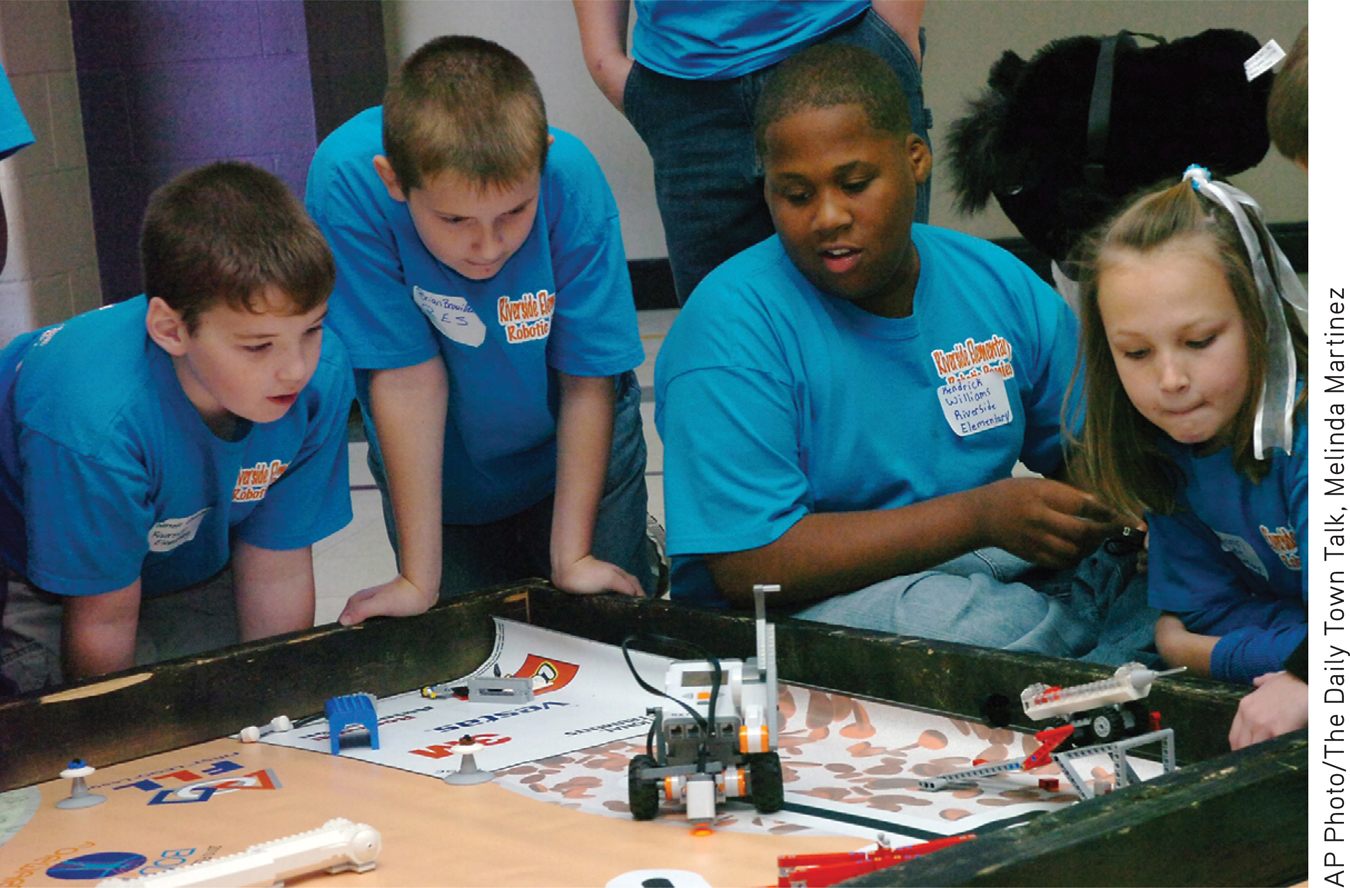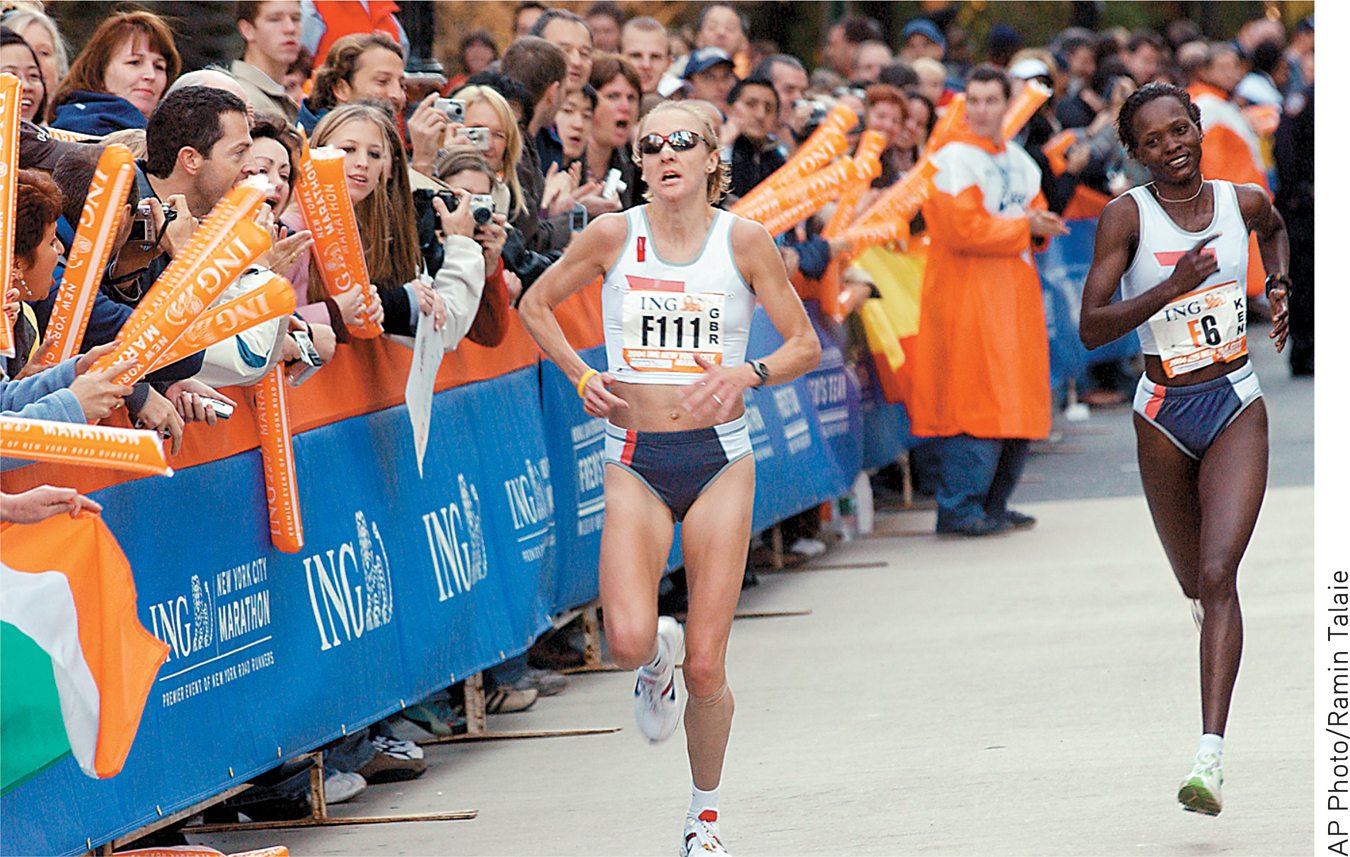12.9 The Influence of Groups on Individual Behavior
KEY THEME
Individual behavior can be strongly influenced by the presence of others.
KEY QUESTIONS
What are social loafing and social striving?
What are social facilitation and deindividuation?
In our discussions of conformity, obedience, and altruism, we have touched on a variety of ways in which the presence of other people influences an individual’s thoughts and behavior. In this section, we’ll focus directly on how the behavior of individuals can be affected by being part of a group. As you’ll see, the diffusion of responsibility that can occur when a group of people observes someone who needs help also contributes to other aspects of group behavior.
Social Loafing: WHEN INDIVIDUAL EFFORT IS “LOST IN THE CROWD”
The performance and motivation of individuals who are part of a group can be influenced by many different factors (Hogg, 2010). Whether it’s cheering, clapping, or rope pulling, people tend to expend less effort on collective tasks than they do when performing the same task alone, a phenomenon called social loafing. You may have experienced social loafing when you participated in a group project for school. Have you ever felt the frustration when your group earned an A, but one of your group members did almost nothing to deserve that grade? Social loafing is especially pronounced when it’s difficult or impossible to assess each individual’s contribution to the collective effort. As a general rule, the greater the number of people involved in a collective effort, the lower each individual’s output (Karau & Williams, 1993).
social loafing
The tendency to expend less effort on a task when it is a group effort.
Is social loafing inevitable in any group task? Not at all. Psychologists Steven Karau and Kipling Williams (1993) conducted a meta-analysis of more than 70 social loafing studies. Collectively, the studies indicate that social loafing is reduced or eliminated when (1) the group is composed of people we know, (2) we are members of a highly valued group, or (3) the task is meaningful or unique. Interestingly, some gender differences also surfaced. Women are generally less likely to engage in social loafing than are men. And when the group size increases, the degree of social loafing increases for men, but not for women (Kerr & Tindale, 2004).

Why does social loafing occur? Like the diffusion of responsibility that occurs when a group witnesses someone who needs help, a similar diffusion of responsibility seems to occur among group members working on a collective task. The responsibility for attaining the group goal is spread across all the group members, resulting in reduced effort by each individual group member (Latané, 1981). Social loafing can also occur because people expect other group members to slack off. To keep the situation equitable, people reduce their efforts to match the level of effort they expect other group members to display (see Kerr & Tindale, 2004).
CULTURAL VARIATIONS: SOCIAL STRIVING
Social loafing is a common phenomenon in individualistic cultures. However, cross-cultural psychologists have found that social loafing is not only absent but reversed in many collectivistic cultures, including in China, Israel, and Japan (Hong & others, 2008; M. Bond & Smith, 1996). That is, individuals worked harder when they were in groups than when they were alone—a pattern referred to as social striving. In the China and Israel studies, those participants who most highly endorsed collectivistic values were most likely to demonstrate increased performance and productivity in groups (M. Bond & Smith, 1996).
Why is social loafing less pronounced or even absent in collectivistic cultures? In collectivistic cultures, group success tends to be more highly valued than individual success. The contributions made by individuals to group success are also more highly valued than they are in individualistic cultures. Finally, the social norms in collectivistic cultures encourage a sense of social responsibility and hard work within groups (Karau & Williams, 1993).
Social Facilitation: INDIVIDUAL PERFORMANCE IN THE PRESENCE OF OTHERS
When your individual efforts go undetected and are “lost in the crowd,” individual performance may drop. But what if your individual efforts are not lost in the crowd but, instead, are the focus of the crowd’s attention? Would your performance then be the same in the presence of others as it would be if you were working alone?

Partly, it depends on the complexity of the task that you’re trying to perform. When a task is relatively simple or well rehearsed, the presence of other people tends to enhance individual performance, a pattern called social facilitation. So when others are watching you perform simple multiplication tables, your individual performance tends to improve. However, if the task is complex or poorly learned, such as a complex memory task, the opposite effect can occur: The presence of other people is likely to hinder performance (Allport, 1920, 1924; Travis, 1925).
social facilitation
The tendency for the presence of other people to enhance individual performance.
How can this be explained? Several factors are involved (Geen, 1995; Guerin, 2003). The presence of others tends to increase our level of arousal and motivation, possibly because of concerns over being favorably or unfavorably evaluated by others. When a task is simple or well learned, increased motivation, spurred on by the anticipation of being positively evaluated, seems to work to our benefit. Under these conditions, social facilitation often occurs: Individual performance is better in the presence of others. Hence, a well-trained athlete is likely to perform better when others are present than when alone (Guerin, 1986).
However, when the task is complex or poorly learned, arousal coupled with apprehension about being negatively evaluated tends to work against us. Under these conditions, the presence of others can diminish an individual’s performance. For example, the apprehensive actor who is not as well rehearsed as he should be may end up missing cues and flubbing lines in front of the opening night audience.
Deindividuation: WHEN GROUP MEMBERS FEEL ANONYMOUS
What happens when you combine the increased arousal due to the presence of others with the diffusion of responsibility that characterizes social loafing and the bystander effect? In combination, increased arousal and a diminished sense of responsibility can lead to deindividuation. Deindividuation refers to the reduction of self-awareness and inhibitions that can occur when a person is part of a group whose members feel anonymous (Zimbardo, 2004a).
deindividuation
The reduction of self-awareness and inhibitions that can occur when a person is a part of a group whose members feel anonymous.
Under these conditions, people may do things that they wouldn’t do if they were alone or identifiable. In this way, deindividuation can lead to irresponsible or antisocial behaviors. For example, deindividuation can help explain adolescent acts of vandalism on Halloween. Succumbing to the feeling of anonymity provided by darkness and Halloween masks, groups of otherwise law-abiding teenagers may commit minor acts of vandalism, such as smashing pumpkins, stealing Halloween decorations, and damaging mailboxes.
The deindividuation people experience when they interact anonymously in online contexts also can lead them to engage in antisocial behavior. Examples include cheating in online games, trolling, and online aggression, often called cyberbullying (Chen & Wu, 2013; Sticca & Perren, 2012). Cyberbullying can have serious consequences. Research has demonstrated a link between cyberbullying and suicidal thoughts in the victim, with some people even attempting or committing suicide following severe online aggression (Hinduja & Patchin, 2010).
Serious consequences can result from deindividuation in person, as well as online. For example, during a mob or a riot, the large crowd of people and general social chaos heighten both arousal and the sense of anonymity. This volatile combination can lead to mobs of rioting people who smash windows, steal, and injure innocent bystanders.

Similarly, onlookers are more likely to taunt someone who is threatening a suicidal jump when the incident occurs at night. The darkness of the night adds to the sense of anonymity felt by members of the crowd, who sometimes collectively start chanting, “Jump! Jump! Jump!” Not surprisingly, people are much less likely to urge on the would-be jumper when they are in small groups or during the day, when there is less of a sense of anonymity (Mann, 1981).
How can deindividuation be counteracted? An important element of deindividuation is the reduced sense of self-awareness (Diener, 1980; Mullen & others, 2003). Thus, one way to counteract deindividuation is to heighten self-awareness. For example, when a mirror was placed above a bowl of Halloween candy, unattended trick-or-treaters were less likely to take more candy than they were told they could take (Beaman & others, 1979). Simply seeing their own faces in the mirror increased personal self-awareness and reduced impulsive, dishonest actions. In contrast, trick-or-treaters who did not see their faces in a mirror were more likely to take more candy than they were supposed to.
Question 12.20
0LyUOKOFk4F0iVkAfi3Huzvs+moYFaoW0DZ16ojU0UMBIJ1ufWyC5wVoj6E/xG29ULC5rvHTbDV6a/tv/fXbwWSjs1MhktdC3flflZCpK9cFEcfDfVelKGGVqatnU06l40zoZCibbkykgIDW4frFWTkwg0M3WYQ71EGHpRPMoApR9CdS+GyYSewKHLmvRgA+xnYY1lDkLzd/7ua4EXXO4us8AjqnN0lFnQHmQs6ZfpEAUimdqx5RfDIrGYeiGShgmrcgzK5IPQPpojV0CONCEPT REVIEW 12.4
Influence of Groups on Individual Behavior
Match each example with the correct concept.
social facilitation
social striving
social loafing
deindividuation
Question 12.21
| 1. | ____ When the Slammers won the play-offs on Friday night, the excitement and chaos following the game turned into a riot, and several stores were looted. |
Question 12.22
| 2. | ____ In a social psychology experiment, university students picked up less litter per person when they were members of a large group than when they worked alone. |
Question 12.23
| 3. | ____ A team of workers in a car factory in Thailand is much more productive than are the individual team members when they work alone. |
Question 12.24
| 4. | ____ Nina’s best running time during practice was 5 minutes and 12 seconds for one mile. During the actual race, however, her time improved to 4 minutes and 42 seconds for one mile. |
Test your understanding of Altruism and Aggression and the Influence of Groups with
 .
.
Closing Thoughts
We began this chapter with a prologue about Fern trying to help a stranger in a strange city. As it turned out, Fern’s social perceptions of the man were inaccurate: He was not a homeless person living on the streets of San Francisco. As simple as this incident was, it underscored a theme that was repeatedly echoed throughout our subsequent discussions of person perception, attribution, and attitudes. Our subjective impressions, whether they are accurate or not, play a pivotal role in how we perceive and think about other people.
A different theme emerged in our later discussions of conformity, obedience, helping behavior, and hurting behavior. Social and situational factors, especially the behavior of others in the same situation, can have powerful effects on how we act at a given moment. But like Fern, each of us has the freedom to choose how we respond in a given situation. When we’re aware of the social forces that influence us, it can be easier for us to choose wisely.
In the final analysis, we are social animals who often influence one another’s thoughts, perceptions, and actions, sometimes in profound ways. In the following Psych for Your Life section, we’ll look at some of the ways that social psychological insights have been applied by professional persuaders—and how you can counteract attempts to persuade you.